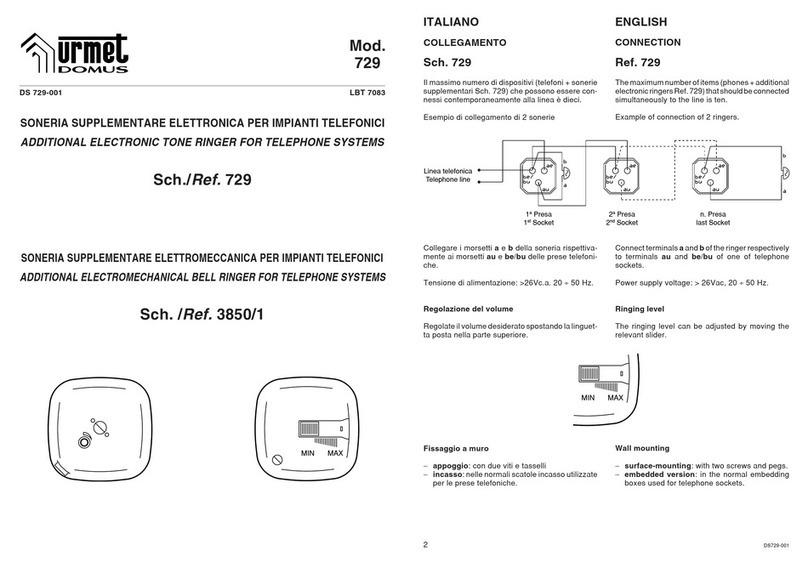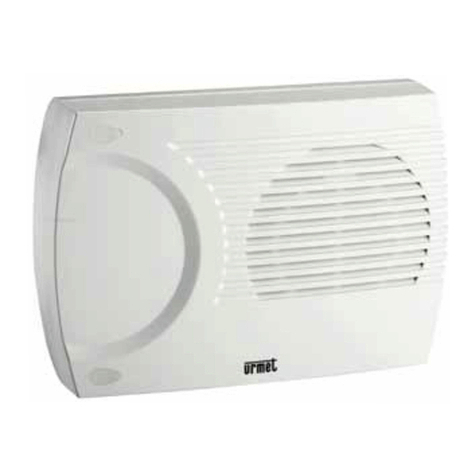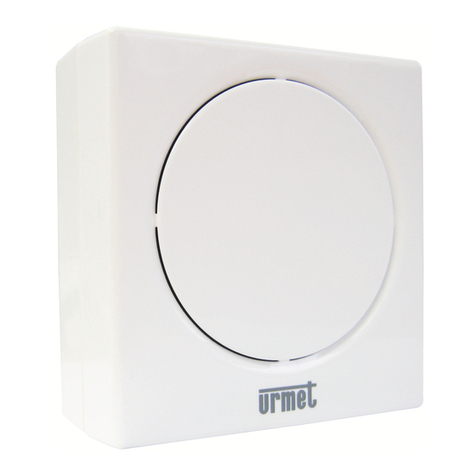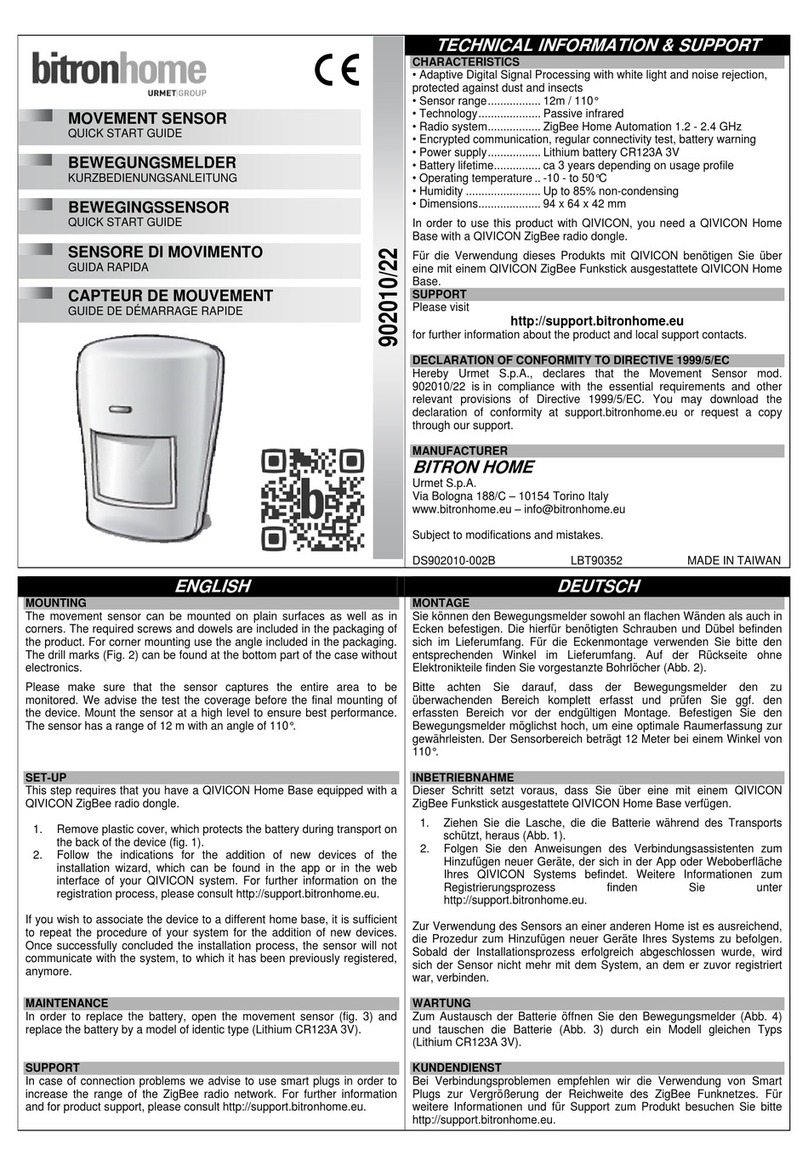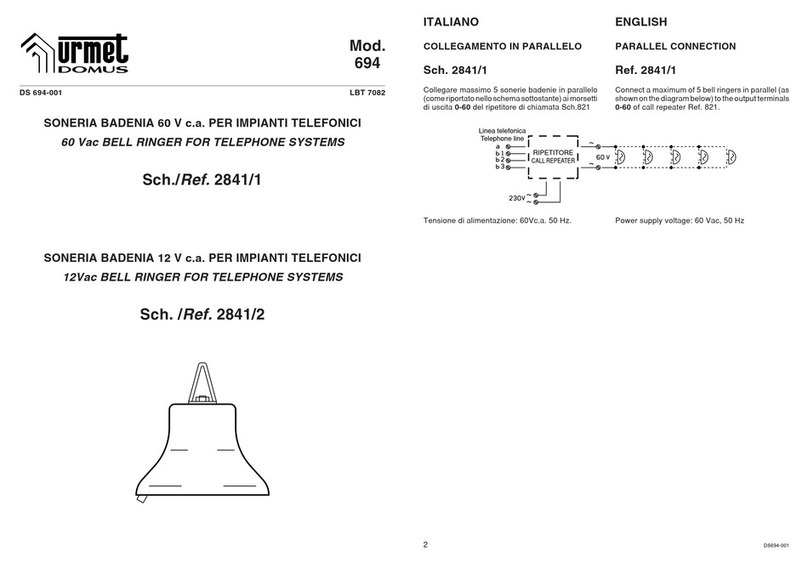
Fondo plastico del sensore (Fig. 2):
•F1-F4 = PREDISPOSIZIONI PER IL FISSAGGIO AD ANGOLO
•A-B = PREDISPOSIZIONI PER IL FISSAGGIO SU SUPERFICIE PIANA
•C-D = PREDISPOSIZIONI PER IL PASSAGGIO CAVI
Fissare il fondo plastico alla parete con le viti e i tasselli, avendo cura che le teste
delle stesse non tocchino la scheda elettronica. Rimontare il circuito sul fondo
plastico.
È importante, terminato l’orientamento, bloccare il movimento dello snodo
serrando a fondo la vite fornita a corredo dello snodo.
DESCRIZIONE MORSETTIERA
IDa non utilizzare
- + Alimentazione 12V
NC TAMP Contatto N.C.
NC ALL Contatto N.C. del relè di allarme
PRIMA ALIMENTAZIONE
Fornita l’alimentazione, il sensore entra nella fase di inizializzazione, durante la
quale i 3 LED lampeggiano alternativamente. Dopo questa fase (che dura 60
secondi circa), il sensore diventa operativo.
In questa modalità, indipendentemente dallo stato del Jumper di LED OFF, il
sensore visualizzerà le rilevazioni della Microonda, quelle dell’Infrarosso e lo
stato di Allarme per permettere all’Installatore di verificarne il funzionamento.
Questa condizione permane per 20 minuti.
Trascorso questo tempo il Sensore visualizzerà:
se in Led ON ( Jumper inserito) solo gli Allarmi tramite il led Blu;
se in Led OFF (Jumper NON inserito) solo eventuali memorie.
Procedere con il walk test in questo modo:
MW (Microonda)
Regolare il trimmer (portata 0,5 - 15 m) in funzione dell’ambiente da proteggere,
verificando le rilevazioni di MW tramite il LED VERDE.
Nota: la portata della MW va regolata al minimo necessario poiché, essendo le
Microonde in grado di oltrepassare i muri, possono rilevare disturbi e movimenti
all’esterno del locale da proteggere.
INFRAROSSO (PIR)
Applicare il frontale plastico e, a LED spenti, muoversi nell’area di pertinenza del
sensore verificando la rilevazione del PIR tramite il LED GIALLO.
FUNZIONI
AUTOMATIC ECO
Il sensore è equipaggiato con uno speciale algoritmo che riduce al minimo le
emissioni della Microonda. Il sensore, tramite il monitoraggio dei movimenti
nell’ambiente, determina se l’impianto è inserito o disinserito.
Questa cognizione gli permette di limitare al massimo le emissioni di Microonda
ad impianto disinserito e quindi di non irradiare inutilmente le persone presenti
nell’ambiente.
Si ottiene questo vantaggio pur senza avere nessuna perdita di sensibilità di
rilevazione, né di immunità ai falsi allarmi.
LED OFF - Jumper Disinserito (di fabbrica inserito)
Disattiva le visualizzazioni di rilevazione, mantenendo abilitate le visualizzazioni
relative alle memorie.
Tavola dei paesi in cui le frequenze del prodotto sono limitate o non
ammesse
DICHIARAZIONE DI CONFORMITÀ UE SEMPLIFICATA
Il fabbricante, URMET S.p.A., dichiara che il tipo di apparecchiatura radio:
RIVELATORE DOPPIA TECNOLOGIA Sch. 1033/132 è conforme alla direttiva
2014/53/UE. Il testo completo della dichiarazione di conformità UE è disponibile
al seguente indirizzo Internet: www.urmet.com
DIRETTIVA 2012/19/UE DEL PARLAMENTO EUROPEO E DEL CONSIGLIO
del 4 luglio 2012 sui rifiuti di apparecchiature elettriche ed elettroniche
(RAEE).
Il simbolo del cassonetto barrato riportato sull’apparecchiatura o sulla
sua confezione indica che il prodotto alla fine della propria vita utile deve
essere raccolto separatamente dagli altri rifiuti. L’utente dovrà, pertanto,
conferire l’apparecchiatura giunta a fine vita agli idonei centri comunali
di raccolta differenziata dei rifiuti elettrotecnici ed elettronici. In alternativa alla
gestione autonoma è possibile consegnare l’apparecchiatura che si desidera
smaltire al rivenditore, al momento dell’acquisto di una nuova apparecchiatura di
tipo equivalente. Presso i rivenditori di prodotti elettronici con superficie di vendita
di almeno 400 m2 è inoltre possibile consegnare gratuitamente, senza obbligo di
acquisto, i prodotti elettronici da smaltire con dimensione massima inferiore a 25
cm. L’adeguata raccolta differenziata per l’avvio successivo dell’apparecchiatura
dismessa al riciclaggio, al trattamento e allo smaltimento ambientalmente
compatibile contribuisce ad evitare possibili effetti negativi sull’ambiente e sulla
salute e favorisce il reimpiego e/o riciclo dei materiali di cui è composta
l’apparecchiatura.
D E RUS
SVK UK
Plastic bottom of the sensor (Fig. 2):
•F1-F4 = SET-UP FOR FIXING IN CORNER
•A-B = SET-UP FOR FIXING ON FLAT SURFACE
•C-D = SET-UP FOR CABLE PASSING
Fix the plastic bottom to the wall with screws and anchor bolts being careful
that they do not touch the electronic board.
Refit the circuit onto the plastic
bottom.
TERMINAL BOARD DESCRIPTION
I Not to be used
- + 12V power
NC TAMP NC contact
NC ALL NC alarm relay contact
FIRST POWER-ON
When power is connected, the sensor will start an initialising step during
which the three LEDs will blink alternatively. The sensor will start working
after this step (which lasts approximately 60 seconds). In this mode,
regardless of the state of the LED OFF jumper, the sensor will show the
microwave detections, the infrared detection and the alarm state to allow the
installer to check operation. This condition will persist for 20 minutes.
The following will appear on the sensor after this time:
in LED ON mode (jumper on) alarms only by means of the blue LED;
in LED OFF mode (jumper NOT inserted) memories only.
Proceed with the walk test, as follows:
MW (Microwave)
Set the trimmer (range 0,5 - 15 m) according to the environment to be
protected and check the MW detections by means of the GREEN LED.
Note: The MW range must be set to the minimum because microwaves can
cross walls and detect disturbances and movements outside the room to be
protected..
INFRARED (PIR)
Apply the plastic front and with the LEDs off move in the area of pertinence
of the sensor checking PIR detection using the YELLOW LED.
FUNCTIONS
AUTOMATIC ECO
The sensor is provided with a special algorithm which reduces to the
microwave emissions to the minimum.
The sensor determines whether the system is on or off by monitoring the
movements in the environment.
This allows to limit microwave emissions to the minimum when the system is
off and to avoid unnecessary radiations for the people present in the
environment. This advantage is achieved without losing detection sensitivity
or false alarm immunity.
LED OFF - Jumper off (on by default)
Deactivates the detection views maintaining the memory views enabled.
Countries in which the product frequencies are restricted or not allowed
SIMPLIFIED EU DECLARATION OF CONFORMITY
Hereby, URMET S.p.A. declares that the radio equipment type: DUAL
TECHNOLOGY DETECTOR Ref. 1033/132 is in compliance with Directive
2014/53/EU. The full text of the EU declaration of conformity is available at
the following internet address: www.elkron.com
DIRECTIVE 2012/19/EU OF THE EUROPEAN PARLIAMENT AND OF THE
COUNCIL of 4 July 2012 on waste electrical and electronic equipment
(WEEE).
The symbol of the crossed-out wheeled bin on the product or on its
packaging indicates that this product must not be disposed of with
your other household waste.
Instead, it is your responsability to dispose of your waste
equipment by handing it over to a designated collection point for the
recycling of waste electrical and electronic equipment. The separate
collection and recycling of your waste equipment at the time of disposal will
help to conserve natural resources and ensure that it is recycled in a
manner that protects human health and the environment.
For more information about where you can drop off your waste equipment
for recycling, please contact your local city office, your household waste
disposal service or the shop where you purchased the product.
D E RUS
SVK UK
http://www.urmet.com - info@urmet.com
Via Bologna 188/C - 10154 TORINO (ITALY) Telef. 011.24.00.000 (RIC. AUT.) / Fax
Area tecnica servizio clienti +39.011.23.39.810
Made in Italy

